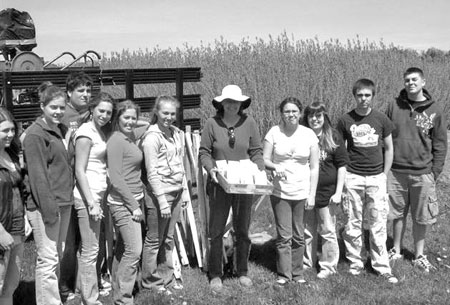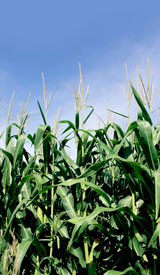May 30, 2007
Contacts: Cornell University: Dr. Donald R. Viands, 607-255-3081,
Julie L. Hansen, Hilary Mayton,
607-255-5043; Dr. Jerry H. Cherney, 607-255-0945; Cornell Cooperative
Extension: Jefferson County: Michael E. Hunter, 315-788-8450, St.
Lawrence County: Peter M. Barney, 315-379-9192:
Belleville-Henderson Central School: Stephen Jones, 315-846-5121
Evaluating Grasses as Bioenergy Crops:
New Plantings at Belleville-Henderson School Among Those In & Planned
for NNY

Cornell
University Research Associate Julie L. Hansen and Belleville-Henderson
FFA students prepare to plant seed for the grasses-to-energy project at
the school in Southern Jefferson County. Photo: Stephen Jones,
Belleville-Henderson Central School.
Belleville, NY � How good is grass as a bioenergy crop? Cornell
University researchers, FFA students and Northern New York farmers
expect to answer that question with the results of grass trials recently
planted at Belleville-Henderson Central School. Over the next two years,
24 plots of switchgrass, indiangrass, big bluestem, and Eastern
gamagrass and species mixes will be evaluated as bioenergy crops grown
under local conditions. The plantings join existing and new trials in
St. Lawrence County; new trials are planned for Eastern Northern New
York in 2008.
The research into the value of the warm season grasses is funded by the
farmer-driven Northern New York Agricultural Development Program (NNYADP)
specific to Jefferson, Lewis, St. Lawrence, Franklin, Clinton and Essex
counties; the New York Farm Viability Institute; and Cornell
University�s NYS Agricultural Experiment Station. NNYADP board member
and beef farmer Don Holman says, �The opportunities for grass-based
agriculture in Northern New York are exploding � from grass-fed
livestock production to growing grasses to power our equipment and
farms, heat our homes, and sell. Testing under our local climate and
growing conditions provides valuable data for farmers to factor into our
decision-making.�
Dr. Donald R. Viands, a plant breeder, and Plant Breeding and Genetics
Research Associate Julie L. Hansen, both of Cornell University, and
Cornell Cooperative Extension Associate Hilary Mayton are the grasses
project leaders. A plant pathologist, entomologist, weed scientist, crop
and nutrient management specialists, and staff at the USDA Big Flats
Plant Materials Center in Corning, NY, will assess the entire feedstock
production system for the grasses. An economist will analyze 2008 field
samples data for the grasses� income potential.
The Belleville-Henderson grass plots, planted next to a willow biomass
project, will be evaluated for seedling stand and vigor in four to six
weeks. The plots will be clipped to reduce weed pressure since the most
effective herbicide for the grasses is not approved for use in New York
State. Hansen says, �This year we want to see these warm weather grasses
establish themselves. Then they have to survive the Northern New York
winter. These varieties have a high yield potential but we do not know
how they will weather the cold northern climate. Next year we will let
the grasses grow and evaluate them for yield, BTUs per acre and the
potential to produce ethanol per acre.�
Viands says, �Grass and legume crops potentially provide more economical
and environmentally sustainable feedstocks than corn for ethanol
production. Their perennial growth eliminates the costs associated with
an annual crop and they are environmentally more sustainable because of
their lower nutrient inputs and because their root system holds the soil
against erosion and they require less land disturbance as they grow.�
Belleville-Henderson Central School sits amidst a largely agricultural
land base in Southern Jefferson County. Cornell Cooperative Extension
Field Crops Educator Michael E. Hunter says the school campus is an
ideal location for the grasses trial. Not only did the school students
clear the field plots of rocks prior to planting, they are an ideal
audience for this type of project.
�Bioenergy is an issue that we need to put in front of our school-age
children. What better way than to bring the issue to the attention of
students than to have the rare opportunity to place a field trial at a
school with an active FFA group and agriculture teacher,� Hunter says,
�and having the grass trial next to the willow biomass � another up and
coming biomass crop - at the school offers a nice side-by-side
comparison of two really different crops.�
Belleville-Henderson agriculture teacher and FFA Advisor Stephen Jones
says, �Having the grass research trials at our high school is a unique
opportunity for our agriculture science students. Students can have
first-hand knowledge and experience in future potential energy sources.
This also gives us the opportunity to work with research scientists from
top notch universities and to see, in-person, the procedures they use in
plant science research.�
Research Puts NNY Farmers Ahead of Energy Curve Hunter says grass crops
first found favor with conservationists looking to provide cover for
birds and other wildlife. Interest in the grasses to produce heat and
farm income is more recent and gaining interest throughout Northern New
York. He says that, as markets build for cellulosic fuel sources, trials
such as those at the Belleville-Henderson school, earlier and
new-in-2007 grass trials at the Cornell Cooperative Extension Learning
Farm in Canton in St. Lawrence County, and plantings to follow in
Eastern New York in 2008 provide educators with answers to the questions
that will come as farmers look at alternative crops.
�This research puts us a step ahead for when the phone calls start and
farmers want to know which biofuel crops will produce the best under our
Northern New York growing conditions. With these trials we can give
those farmers a head start,� Hunter says.
New York State Forage Specialist and Cornell Crop and Soil Sciences
Professor Dr. Jerry H. Cherney, who is evaluating the pelletizing of
grass crops for fuel production, says, �Grass biofuel for combustion
should eventually surface as one of the alternative solid biomass
winners.�
Hunter notes that Sundance Pool and Leisure of Watertown successfully
burned switchgrass pellets in a biomass stove at the 2007 Spring Home
Show at the Jefferson County Fairgrounds and that a Pennsylvania company
is about to debut a tractor-driven hay pelletizer that could encourage
additional interest in on-farm development of the grass crops. At an
expected cost of up to $80,000 for the new machine, the potential may
exist for a custom service that would go from farm to farm to pelletize
the grasses.
The Northern New York Agricultural Development Program is a
farmer-driven research, education and outreach program funding projects
that take place on regional farms, at the research farms in Northern New
York. To learn more about the Program and its projects, go online to
www.nnyagdev.org or call your
local Cornell Cooperative Extension office.




